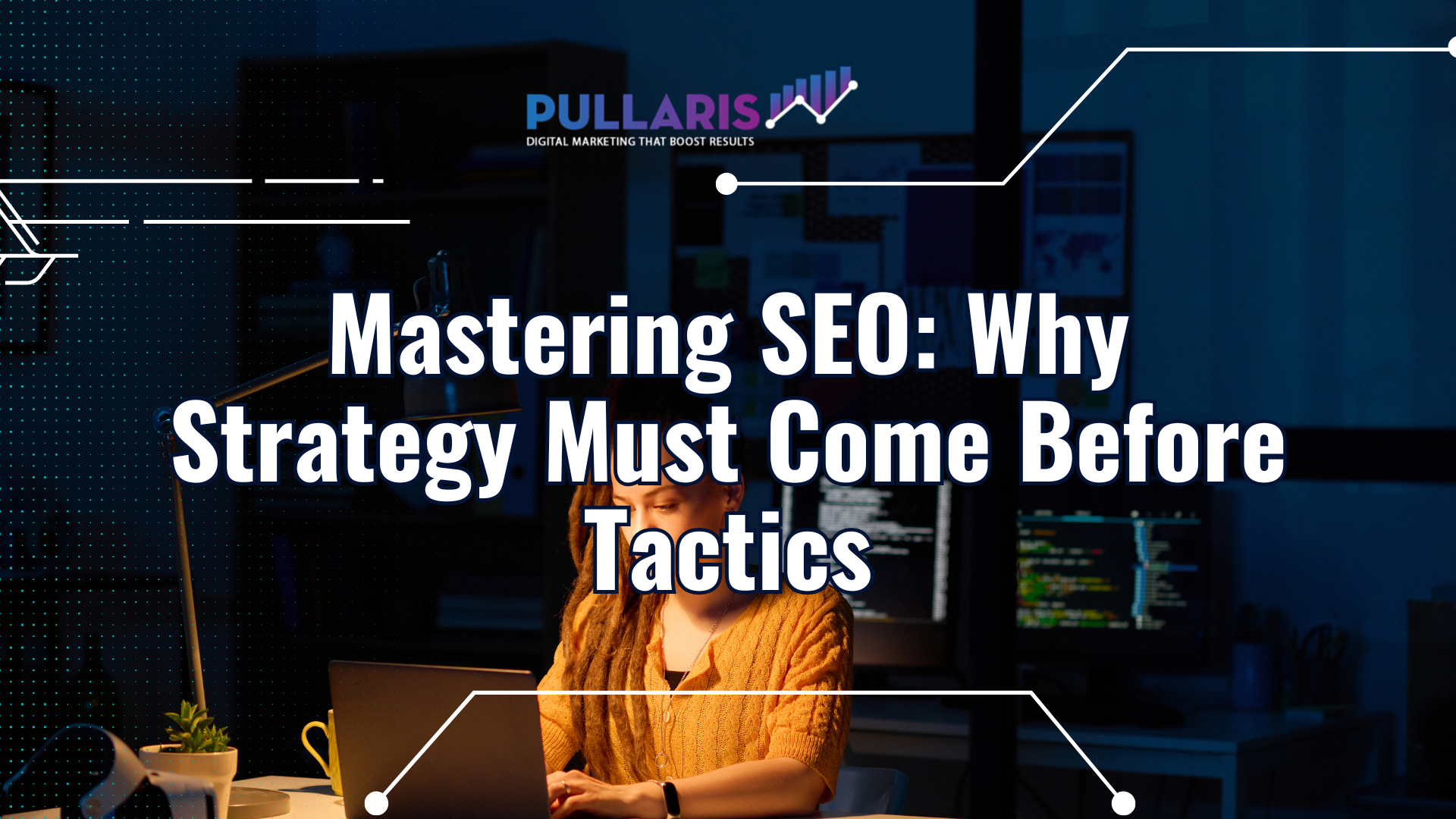Mastering SEO: Why Strategy Must Come Before Tactics
Mastering SEO: Why Strategy Must Come Before Tactics


In the ever-evolving world of digital marketing, countless businesses rush into tactics—publishing blog posts, building backlinks, tweaking title tags—without first establishing a clear plan. While these individual actions can yield short-term gains, they often fail to produce lasting results or align with broader business goals. That’s where “Strategy Before Tactics” comes in: a disciplined, research‑driven approach that ensures every move you make directly supports your long‑term objectives and delivers sustainable growth.
1. The Limits of Tactical‑Only SEO
Jumping straight into tactical SEO is like setting sail without a map. You might make progress, but you won’t know if you’re headed toward your desired destination. Common pitfalls include:
-
Chasing Vanity Metrics: Focusing on raw traffic or high keyword rankings without regard for conversion rates, engagement, or revenue impact.
-
Scattered Efforts: Investing time in minor fixes—like adding alt text to images—while overlooking major obstacles such as site architecture or content gaps.
-
Short‑Lived Wins: Quick optimizations can cause temporary ranking boosts, but without an overarching plan, these gains rarely stick.
By contrast, a strategy‑first approach keeps your team aligned, resources prioritized, and outcomes measurable.
2. Crafting Your SEO Strategy
Before writing a single meta description or reaching out for backlinks, answer these foundational questions:
-
Who Is Your Audience?
-
Identify your ideal customers’ demographics, interests, and most common search behaviors.
-
Map their journey from awareness to decision, and understand the types of content that resonate at each stage.
-
-
What Are Your Goals?
-
Are you aiming to boost brand visibility, generate qualified leads, or increase online sales?
-
Define specific, measurable objectives—such as a 25% increase in organic demo requests within six months.
-
-
Where Do You Compete?
-
Conduct thorough keyword research to uncover high‑value terms and content opportunities.
-
Analyze competitors’ strengths and weaknesses to identify gaps you can exploit.
-
With these insights, you can build a clear roadmap that turns strategy into action.
3. The Four Phases of Strategic SEO Planning
An intentional SEO plan unfolds in distinct, interlocking phases:
A. Audit & Research
-
Technical Health Check: Crawl your site to uncover issues like broken links, duplicate content, or slow page speeds.
-
Content Inventory: Catalog existing pages, blog posts, and resources to identify underperformers and opportunities for consolidation.
-
Backlink Analysis: Review your current link profile to spot toxic links to remove and authoritative domains to pursue.
B. Goal Setting
-
Translate insights from the audit into SMART objectives:
-
Specific (e.g., “Increase organic traffic to our software features pages”)
-
Measurable (e.g., “by 40% over the next 12 months”)
-
Achievable (based on historical performance)
-
Relevant (aligned with revenue targets)
-
Time‑bound (with quarterly milestones)
-
C. Roadmapping
-
Prioritize initiatives by impact and effort:
-
High Impact, Low Effort: Quick wins like optimizing top‑performing blog posts for related keywords.
-
High Impact, High Effort: Major projects like a full site restructuring or building cornerstone content hubs.
-
Low Impact, High Effort: Tackle only if resources allow—such as redesigning underutilized landing pages.
-
D. Execution & Measurement
-
Deploy tactics in sprints, each tied to specific KPIs (organic traffic, conversion rate, backlink growth).
-
Use dashboards to track progress in real time and adjust course as needed.
4. Translating Strategy Into Powerful Tactics
When tactics flow from strategy, they no longer feel like random tasks but targeted levers that move the needle:
-
Keyword Mapping: Assign each keyword group to a dedicated page or content cluster, ensuring clear relevance and preventing internal competition.
-
Content Creation: Develop in‑depth articles, guides, and multimedia that align with user intent—whether that’s learning, comparing options, or making a purchase.
-
On‑Page Optimization: Craft compelling titles, headers, and meta descriptions that reflect both your strategic priorities and natural search language.
-
Link Acquisition: Focus outreach on websites whose audiences mirror yours, securing high‑quality backlinks that boost authority and referral traffic.
Each of these tactics is powerful on its own, but when orchestrated within a holistic plan, they amplify one another and produce exponential returns.
5. Why Pullaris Leads with Strategy
At Pullaris, we’ve seen firsthand how a “tactics‑first” mentality can waste months of effort. That’s why we center every engagement around strategic planning:
-
Collaborative Workshops: We kick off with deep‑dive sessions to align SEO objectives with your marketing roadmap and business KPIs.
-
Data‑Driven Roadmaps: Leveraging advanced analytics, competitor insights, and industry benchmarks, we create prioritized plans that maximize ROI.
-
Transparent Communication: Regular strategy reviews and easy‑to‑read dashboards keep you informed of progress and upcoming initiatives.
-
Continuous Optimization: SEO isn’t a one‑and‑done project. We constantly refine our approach based on real‑world performance, ensuring sustained growth.
By insisting on strategy before tactics, Pullaris turns SEO from a reactive scramble into a proactive growth engine—delivering measurable improvements in traffic quality, lead generation, and revenue.
6. Take the Strategic Leap with Pullaris
If you’re ready to move beyond disjointed tactics and embrace an SEO program built on solid strategy, Pullaris is here to guide your journey. Together, we’ll craft a roadmap that aligns with your unique goals and unlocks the full potential of organic search. Let’s start planning your path to lasting success today.
